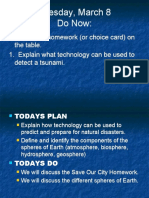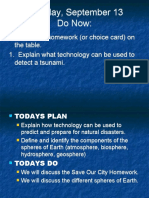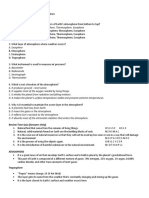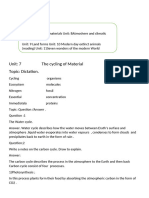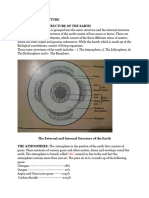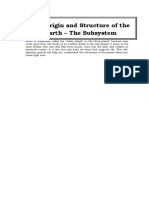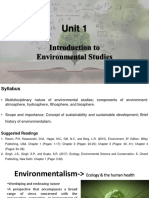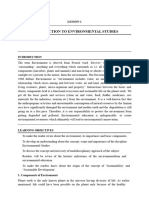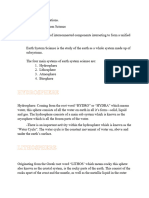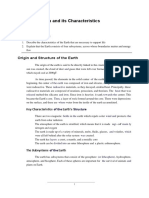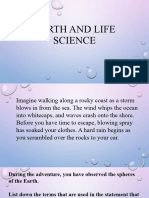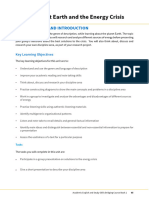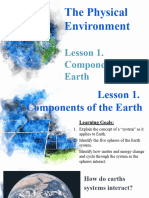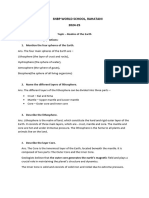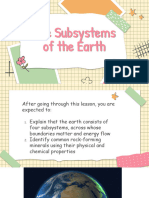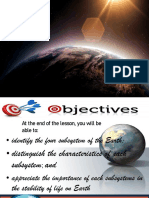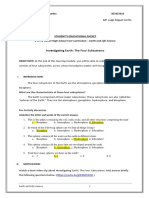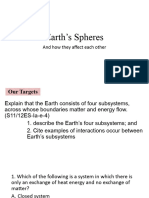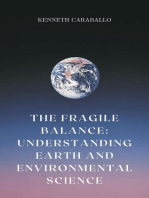G6 S.ST 2
G6 S.ST 2
Uploaded by
My SchoolCopyright:
Available Formats
G6 S.ST 2
G6 S.ST 2
Uploaded by
My SchoolOriginal Title
Copyright
Available Formats
Share this document
Did you find this document useful?
Is this content inappropriate?
Copyright:
Available Formats
G6 S.ST 2
G6 S.ST 2
Uploaded by
My SchoolCopyright:
Available Formats
Name: ________________ Chapter: The Earth is Our Home
Grade: VI Date: ____________ Work Sheet no: .
___________________________________________________________________________
Short Question / Answers:
Q1: Describe four natural spheres of Earth.
Ans: Scientists classify natural spheres of Earth as:
1. Atmosphere(air) 2. Lithosphere(land)
3. Hydrosphere (water) 4. Biosphere(living-things)
ATMOSPHERE
Definition:
“An atmosphere is a blanket of gases that surrounds Earth. Argon, oxygen and
nitrogen are the three main constituents of the atmosphere.”
LITHOSPHERE
Definition:
“The lithosphere is the outer portion of the Earth that consists of the crust and
the upper mantle.”
HYDROSPHERE
Definition:
“All the water found on, under and above the surface of the Earth is known as
hydrosphere.”
BIOSPHERE
Definition:
“The biosphere is the region of Earth where life can be found, including land,
air and water. The lithosphere, hydrosphere, and atmosphere are the names for these
three components.”
Q2: Define lithosphere and name different layers of Earth along with diagram.
Ans: LITHOSPHERE
Definition:
“The lithosphere is the outer portion of the Earth that consists of the crust and
the upper mantle.”
LAYERS OF EARTH:
Following are the names of different layers of Earth:
1. Crust (outermost layer)
2. Mantle (layer below the crust)
3. Core (central zone of the Earth)
DIAGRAM:
Q3: Define plate tectonics and seismic waves.
Ans: PLATE TECTONICS
Definition:
“The lithosphere is broken down into several blocks or plates. These plates move
due to the heat produced by magma and this activity is known as plate tectonics.”
SEISMIC WAVES
Definition:
“When an earthquake happens, it generates waves of energy in the Earth. That’s
why we feel vibrations on Earth. These waves are called seismic waves.”
Long Question / Answers:
Q1: Describe the atmosphere with reference to its layers.
Ans: ATMOSPHERE
Definition:
“An atmosphere is a blanket of gases that surrounds Earth. Argon, oxygen and
nitrogen are the three main constituents of the atmosphere.”
LAYERS OF ATMOSPHERE:
The atmosphere can be divided into five main layers:
1. Troposphere 3. Mesosphere 5. Exosphere
2. Stratosphere 4. Thermosphere
TROPOSPHERE
Definition:
“The troposphere is the lowest layer of the Earth’s atmosphere in direct contact with
Earth’s surface. The weather forms and changes in this layer.”
STRATOSPHERE
Definition:
“The stratosphere is a layer of Earth’s atmosphere. It is the second layer of the
atmosphere as you go upward. This layer includes ozone layer that protects the Earth from
harmful ultraviolet (UV) rays of sun.”
MESOSPHERE
Definition:
“The mesosphere is a layer of Earth’s atmosphere. The mesosphere is directly above
the stratosphere and below the thermosphere. This layer burns meteoroids.”
THERMOSPHERE
Definition:
“The thermosphere is a layer of Earth’s atmosphere. It starts above the mesosphere
and below the exosphere. Here, man-made satellites are found orbiting the Earth.”
EXOSPHERE
Definition:
“The exosphere is a layer of Earth’s atmosphere. It starts above the thermosphere.
Exo means outside, so this is the edge or outermost layer of the Earth’s atmosphere.”
Q3: What are the impacts of human activities? What measures could be taken?
Ans: Environmental Impacts
1. Climate Change:
Activities like burning fossil fuels and cutting down forests release gases that
warm the planet.
Measure:
Use renewable energy, improve energy efficiency, and plant more trees.
2. Loss of Wildlife:
Destroying habitats and pollution harm many species.
Measure:
Create protected areas for wildlife and support sustainable land use.
3. Pollution:
Waste from industries and plastic harms our air, water, and soil.
Measure:
Implement strict rules, promote recycling.
4. Health Problems:
Pollution and unhealthy lifestyles can make people sick.
Measure:
Improve healthcare access and promote healthy living.
5. Resource Shortages:
Unsustainable practices can lead to a lack of essential resources.
Measure:
Promote sustainable farming and responsible consumption.
You might also like
- Module Quarter 1 Earth and Life ScienceDocument18 pagesModule Quarter 1 Earth and Life ScienceEmmanuel Ronquillo100% (1)
- Es Lesson 2 - Q1Document69 pagesEs Lesson 2 - Q1James Hajie GarciaNo ratings yet
- Earth Systems Spheres UseDocument14 pagesEarth Systems Spheres Usetegnap16 tegnap1316No ratings yet
- SUBSYSTEM OF THE EARTHDocument37 pagesSUBSYSTEM OF THE EARTHElysium Balaba Botor100% (4)
- Earth and Life ScienceDocument2 pagesEarth and Life ScienceAmimah Balt GuroNo ratings yet
- Earth Systems Spheres UseDocument13 pagesEarth Systems Spheres UseRhea Ann CaparasNo ratings yet
- Subsystem of The EarthDocument26 pagesSubsystem of The Earthchedternieljacinto123No ratings yet
- SLK Earth Science Week 1Document18 pagesSLK Earth Science Week 1maricarNo ratings yet
- Week 2 ELDocument17 pagesWeek 2 ELSyryll FloresNo ratings yet
- Earth's Structure and System: LessonDocument40 pagesEarth's Structure and System: LessonGlen MillarNo ratings yet
- The Four Subsytems of EarthDocument35 pagesThe Four Subsytems of EarthGERALDINE PEGANONo ratings yet
- Lessson 3 Earths SystemDocument25 pagesLessson 3 Earths Systemmizpehman12No ratings yet
- Earth AtmosphereDocument4 pagesEarth AtmosphereJai Prakash MauryaNo ratings yet
- Science 7 Quarter 4 Week 3 Lesson 1-3Document6 pagesScience 7 Quarter 4 Week 3 Lesson 1-3RAINIER DE JESUSNo ratings yet
- DDDDDDDDDDDDDDDDocument29 pagesDDDDDDDDDDDDDDDchinna25689No ratings yet
- S, ST 6 Grade Key BookDocument6 pagesS, ST 6 Grade Key Bookhummera JabeenNo ratings yet
- The Earth and Its StructureDocument4 pagesThe Earth and Its StructuretosinadebayoabikNo ratings yet
- Atmosphere Lesson Plan 1Document9 pagesAtmosphere Lesson Plan 1sakhi dewaniNo ratings yet
- Earth Science 2nd QuarterDocument11 pagesEarth Science 2nd QuarterJhoana paola SugayNo ratings yet
- Week 2 Module 2 Els Lecture Earth SubsytemDocument9 pagesWeek 2 Module 2 Els Lecture Earth SubsytemScore ExE100% (1)
- Chapter 1Document36 pagesChapter 1Divya GuptaNo ratings yet
- Earth - The Living PlanetDocument44 pagesEarth - The Living PlanetJustin Mhel VaquilarNo ratings yet
- Nguyen Ngoc Tung 20210911 PortfolioDocument27 pagesNguyen Ngoc Tung 20210911 PortfolioNguyễn Ngọc TùngNo ratings yet
- The 4 Subsystem of EarthDocument8 pagesThe 4 Subsystem of EarthYollyNo ratings yet
- EarthSystem LatestpptxDocument55 pagesEarthSystem LatestpptxFrances Corpuz100% (1)
- Notes EVS (Unit 1) PDFDocument15 pagesNotes EVS (Unit 1) PDFSurbhi NaagarNo ratings yet
- Geography EOT PreparationsDocument6 pagesGeography EOT PreparationsannjelemocampbellNo ratings yet
- Subsystem Q1 W1 L2Document25 pagesSubsystem Q1 W1 L2Anico MartinNo ratings yet
- Narrative ReportDocument11 pagesNarrative ReportStephanie Jean Magbanua CortezNo ratings yet
- Section 1 - The Earths System PDFDocument9 pagesSection 1 - The Earths System PDFJoela Faith Ming GongNo ratings yet
- 9th Class-TS-EM-Social Studies-4 - AtmosphereDocument15 pages9th Class-TS-EM-Social Studies-4 - AtmosphereSiddhenki StephenNo ratings yet
- Lesson 2Document5 pagesLesson 2ritzel c. endeNo ratings yet
- (1.2&1.3) Earth's Four Subsystem and Internal StructureDocument21 pages(1.2&1.3) Earth's Four Subsystem and Internal StructureMiguel Jaime C. De LaraNo ratings yet
- Business Ethics & Corporate Governance: NameDocument6 pagesBusiness Ethics & Corporate Governance: NameMasoom RazaNo ratings yet
- Earth Science Week 2 OCRDocument4 pagesEarth Science Week 2 OCRVic Annielyn CoronelNo ratings yet
- Global Geography 12: Unit II - The Planet EarthDocument40 pagesGlobal Geography 12: Unit II - The Planet Earthapi-240746852No ratings yet
- Environmental StudiesDocument76 pagesEnvironmental StudiesRohan SinghNo ratings yet
- Earth SubsystemDocument31 pagesEarth SubsystemyvetteNo ratings yet
- Earth Science SHS Q1 Lesson 4 - Earth's AtmosphereDocument20 pagesEarth Science SHS Q1 Lesson 4 - Earth's Atmosphereteneperelea13No ratings yet
- CB1 Unit 3Document23 pagesCB1 Unit 3info.xd.ovoNo ratings yet
- Figure 1.a: The Geosphere. Illustration From Earth Science: AnDocument8 pagesFigure 1.a: The Geosphere. Illustration From Earth Science: AnJoana Jean Suyman100% (2)
- The Subsystems of The EarthDocument3 pagesThe Subsystems of The Earthyoow.youthNo ratings yet
- Sci ReviewerDocument3 pagesSci ReviewerAleph AninacionNo ratings yet
- Module 1 Lesson 1Document6 pagesModule 1 Lesson 1MARK BRIAN FLORESNo ratings yet
- 1 1 The AtmoshereDocument7 pages1 1 The Atmoshereapi-240094705No ratings yet
- Geography Chapter 6 SST Short QuestionDocument4 pagesGeography Chapter 6 SST Short QuestionPriya SharmaNo ratings yet
- 1 - Components of The EarthDocument18 pages1 - Components of The EarthCathyNo ratings yet
- SNBP World School, Rahatani 2024-25Document4 pagesSNBP World School, Rahatani 2024-25jiya165No ratings yet
- Subsystems - Rock Forming MineralsDocument45 pagesSubsystems - Rock Forming Mineralssantos.johnandrei719No ratings yet
- LESSON 1 - EARTHSUBSYTEMS (Autosaved)Document59 pagesLESSON 1 - EARTHSUBSYTEMS (Autosaved)Kenneth Bigal100% (1)
- Earth's SubsystemsDocument16 pagesEarth's SubsystemsRUTH MIASCONo ratings yet
- Activity 2-Investigating Four Spheres of EarthDocument7 pagesActivity 2-Investigating Four Spheres of EarthAlpha SalcepuedesNo ratings yet
- 1 Spheres ADocument35 pages1 Spheres Abrinamates96No ratings yet
- 2 Earth and Life ScienceDocument28 pages2 Earth and Life ScienceAmy VillaNo ratings yet
- Unit 1 Introduction To Environmental StudiesDocument7 pagesUnit 1 Introduction To Environmental Studiesanirudh shirkeNo ratings yet
- The Fragile Balance: Understanding Earth and Environmental ScienceFrom EverandThe Fragile Balance: Understanding Earth and Environmental ScienceNo ratings yet
- Questions and Answers about: Planet EarthFrom EverandQuestions and Answers about: Planet EarthRating: 3 out of 5 stars3/5 (1)
- Cosmology, Atomic Theory, Evolution: Classic Readings in the Literature of ScienceFrom EverandCosmology, Atomic Theory, Evolution: Classic Readings in the Literature of ScienceNo ratings yet


